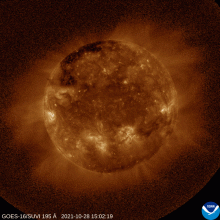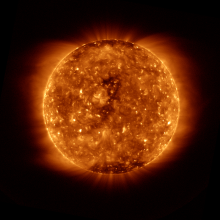The Sun shines on the Daniel K. Inouye Solar Telescope atop Haleakala, a 10,000-foot mountain in Hawaii. The world's largest Sun-watching telescope, it is being commissioned this year. [National Solar Observatory]
You are here
Solar Telescope
The Sun is a giant presence in our sky. So you might think that astronomers don’t need big telescopes to study it. You would be wrong. To learn the details about how the Sun works, astronomers need to see the details on its surface. The bigger the telescope, the more detail.
The world’s largest Sun-watching telescope is scheduled to begin science operations this year. The Daniel K. Inouye Solar Telescope is named for a former U.S. senator from Hawaii. It’s atop Haleakala, a 10,000-foot mountain on Maui. Appropriately enough, Haleakala means “house of the Sun.”
The telescope's main mirror is more than 13 feet in diameter. The telescope will use a technique known as adaptive optics to eliminate the blurring effect of Earth’s atmosphere. The combination will show details that are less than 15 miles across.
Scientists will study what’s happening on the Sun now, and what happens over a period of years.
The short-term observations will allow them to probe the Sun’s magnetic field, which produces sunspots, flares, and other features. That’ll help them understand the dynamo that powers the magnetic field. And it’ll help them understand and predict space weather — interactions between Sun and Earth.
The Sun goes through an 11-year magnetic cycle. And no two cycles are alike. So long-term studies will tell us more about what’s happening inside the Sun over many decades — studies made with a giant telescope atop the house of the Sun.
Script by Damond Benningfield
Get Premium Audio
Listen to today's episode of StarDate on the web the same day it airs in high-quality streaming audio without any extra ads or announcements. Choose a $8 one-month pass, or listen every day for a year for just $30.







